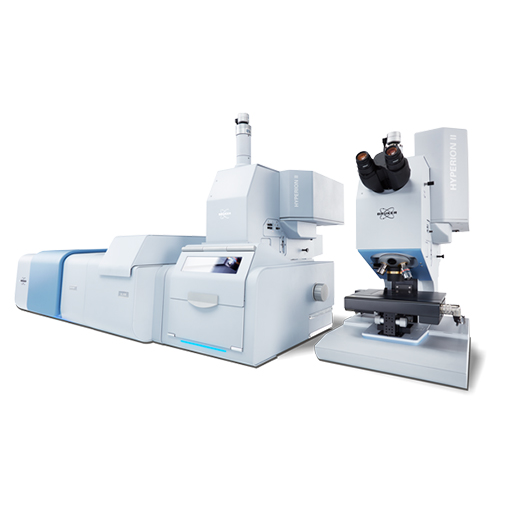
HYPERION II Research FT-IR and QCL Microscope
The HYPERION II is our versatile FT-IR microscope for research and development with flexible accessories and the possibility to combine Infrared Laser Imaging (QCL) and FT-IR in one instrument.
FT-IR meets QCL
Analytical Power and Innovation
The IR Microscopy and Imaging Research Platform
What’s new with HYPERION II:
Marten Seeba is the product manager of the HYPERION II and lead the development to the final stages. He emphasizes the strong history of HYPERION and explains what’s new.
How we integrated infrared laser imaging:
Our QCL pioneer and head of laser microscopy at Bruker, Niels Kroeger-Lui, explains why combining FT-IR and QCL is a true game changer for infrared microscopy.
Our patented spatial coherence reduction:
Our development engineer Sascha Roth provides detailed insights into the development of our patented spatial coherence reduction technology.
FT-IR Microscopy Augmented by QCL | Infrared Laser Imaging
The HYPERION II is an innovation force in infrared microscopy. It provides IR imaging down to the diffraction limit and sets the benchmark in ATR microscopy. It combines FT-IR and Infrared Laser Imaging (ILIM) microscopy for the first time ever in a single device, offering all three measurement modes: transmission, reflection, and ATR.
HYPERION II features:
- Selection of detectors for µ-FT-IR:
Broad-, mid, narrow-band LN2-MCTs,
thermoelectrically cooled (TE) MCT. - Focal-plane array detector for infrared imaging (64 x 64 or 128 x 128 pixel).
- Optional QCL implementation by Laser Infrared Imaging Module (ILIM, laser class 1)
- Objective lens selection: 3.5x/15x/36x IR,
20x ATR, 15x GIR, 4x/40x VIS. - Spectral range extension – from Near-Infrared (NIR) to Far-Infrared (FIR)
- Selection of apertures: manual knife-edge, automated knife-edge aperture wheel. Metal apertures for NIR
- Selection of accessories and sample stages: macro IR imaging accessory, cooling/heating stage, sample compartment, etc.
- Selection of visual/optical tools: Darkfield illumination, Fluorescence illumination, VIS polarizers, IR polarizers, etc.
HYPERION II provides:
- Perfect match of spectral and visual images. Applies to any measurement mode (including ATR imaging).
- Diffraction limited high sensitivity FT-IR microscopy and imaging by using focal plane array (FPA) detector.
- First ever combination of FT-IR and QCL technology by (optional) Infrared Laser Imaging Module (ILIM, laser class 1).
- Infrared laser imaging in all measurement modes (ATR, Transmission, Reflectance).
- Patented coherence reduction for artifact free Laser Imaging measurements without sensitivity or speed loss.
- High imaging speeds:
0.1 mm2per second (FPA, full spectrum)
6.4 mm2 per second (ILIM, single wavenumber) - Optional TE-MCT detector to perform IR microscopy with high spatial resolution and sensitivity without liquid Nitrogen.
- Emission spectroscopy capability and optional spectral range extensions.
HYPERION II applications:
- Life science | cell imaging
- Pharmaceuticals
- Emissivity studies (e.g. LEDs)
- Failure and Root Cause Analysis
- Forensics
- Microplastics
- Industrial R&D
- Polymers & Plastics
- Surface characterization
- Semiconductor
The FT-IR Research Microscope for Pioneers and Innovators
Hardly any of our IR microscopes embody our users like the HYPERION II:
Flexible, precise, configurable, adaptable, and always at the limit of what is possible.
Take Full Control
Above all, it is about having complete access to an instrument. Access to the experiment, the samples, and the parameters. This is the foundation of the HYPERION II and its most valuable asset: providing full control.
Whether FT-IR measurements in single point mode, mapping or imaging with different detectors or objectives, special sample stages or with ATR or Grazing Angle objective. At any point you can influence the outcome of your results – and make them better.
This is the clear difference to our LUMOS II IR microscope. Where the LUMOS II relieves the user of tedious experimental details and automates the measurement process, the HYPERION II remains a precise tool that only does what the user demands.
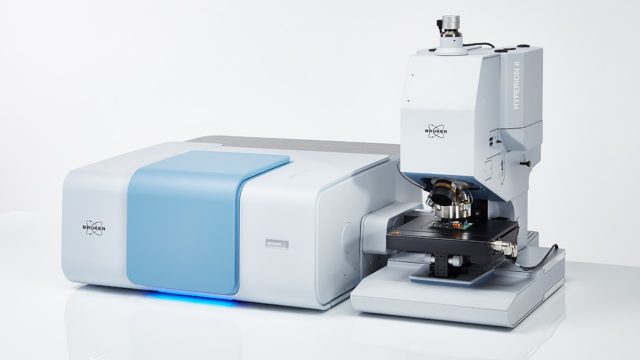
The HYPERION II microscope with MCT detector
A Monument to its Past
Many users know the HYPERION II and its strengths through its predecessor. For almost 20 years, it has been an innovation force in IR microscopy and imaging. The things that made HYPERION an outstanding FT-IR microscope are still there – only better, faster and improved.
The HYPERION II continues to have all the features you require in your daily research routine: liquid nitrogen and thermoelectrically cooled MCTs, focal plane array imaging detectors, visual and infrared enhancement tools, and of course an abundance of dedicated accessories.
In the end, we wanted to set the benchmark in FT-IR microscopy and imaging once again and live up to our name as an innovation leader by introducing new and exciting technology while keeping established and valued methods.
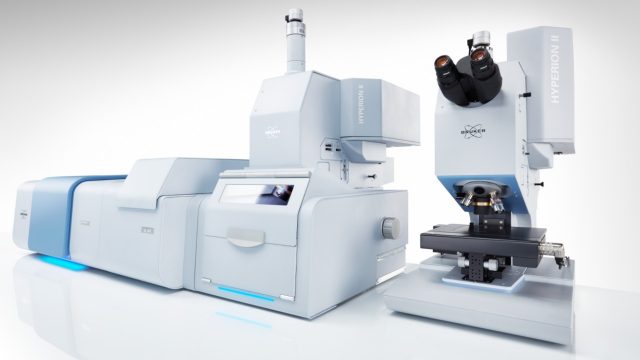
Augmenting FT-IR by Infrared Laser Imaging (QCL)
QCL and FT-IR in a single instrument
For the first time, users can access an IR microscope that combines FT-IR and QCL technology in one instrument. With this, we are opening a completely new door to life science and material research.
Collect an FT-IR spectrum, select the wavelengths you want to investigate using QCL and create stunning chemical images in a matter of seconds.
With this completely new approach of FT-IR and infrared laser imaging, we finally give users, researchers, and scientists a tool to develop new applications, but also to improve established and proven approaches.
A true QCL microscope with exceptional performance
The HYPERION II offers uncompromised QCL microscopy in a state-of-the-art FT-IR microscope. In fact, we have specifically developed and patented a novel coherence reduction technology to enable unparalleled IR laser imaging performance – without digital post-processing.
To illustrate: In classical FT-IR, spatial coherence does not play a role. In IR microscopic measurements with a QCL, however, spatial coherence phenomena inevitably occur. These fringes and speckles in IR images and spectra are generally considered to be harmful for chemical imaging (see adjacent; DOI: 10.1002/jbio.201800015).
Indeed, it is not trivial to separate the sample’s chemical information from the physical information describing the phase relationship of the scattered photons. The HYPERION II addresses this problem pragmatically and solves it by smart hardware design and lets you acquire artifact-free chemical imaging data.
Comparing FT-IR and QCL spectroscopy
Comparing the techniques would imply that both can perform the same task equally well – a popular misconception. FT-IR and infrared laser imaging have distinct advantages and only a practical combination of both can achieve the best results.
We know that most scientists and researcher do not want to miss the universality of FT-IR. They don’t like being restricted to a single, cutting-edge technique without point of reference. Fortunately, the HYPERION II can be considered both: an exceptional FT-IR imaging microscope and an ambitious QCL microscope.
We have addressed this duality and where QCL technology records data significantly faster at the same signal to noise, it is still limited to a small range of the MIR. Again, we stay true to the concept of the HYPERION II. You choose. You have full control.
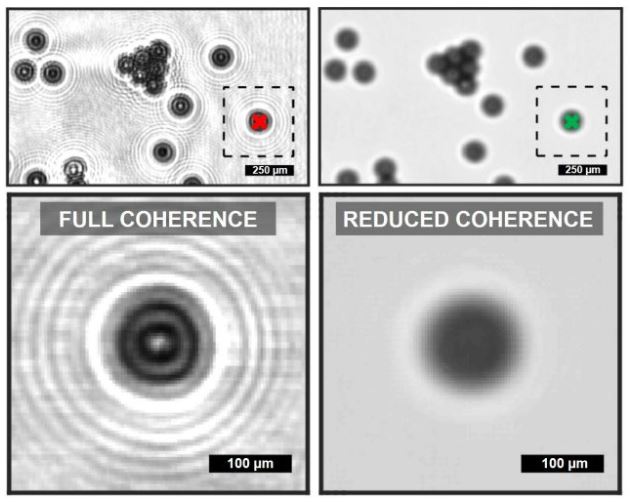
QCL-IR imaging measurements of polystyrene beads. Left: mid-infrared laser imaging with full coherence. Right: mid-infrared laser imaging with reduced coherence. Source: Arthur Schönhals, Niels Kröger-Lui, Annemarie Pucci, Wolfgang Petrich; On the role of interference in laser-based mid-infrared widefield microspectroscopy, Journal of Biophotonics, 2018, Volume 11, Issue 7, DOI: 10.1002/jbio.201800015.
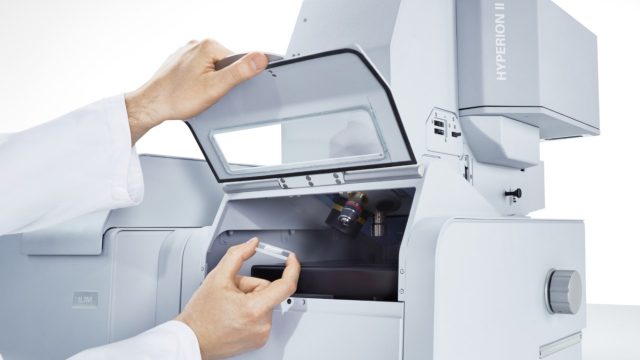
Choose your µ-FT-IR Application
Biological Tissue Analysis
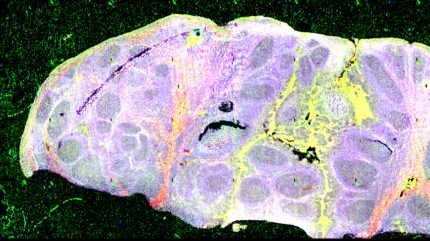
Material Science
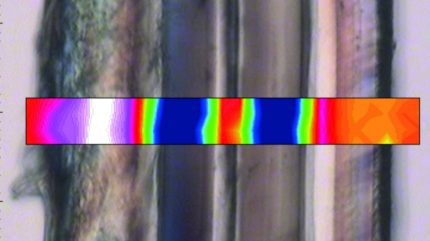
All kinds of organic and inorganic substances are used in industrial manufacturing. and thus, damages and defects can take many different forms. As a truly universal technique, FT-IR microscopy is of great help in these failure and root cause analysis applications.
Forensic Sciences
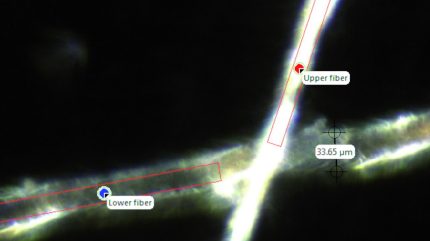
Drug Development
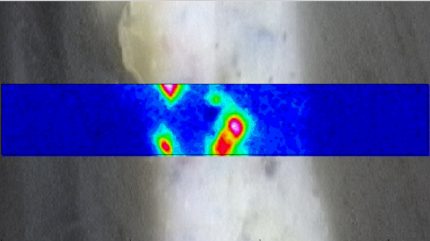
Geology and Mineralogy
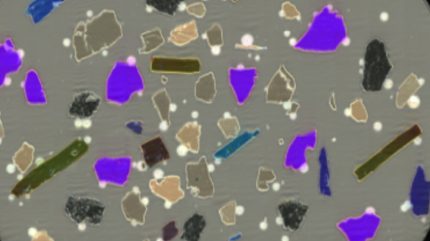
Microplastic Analysis
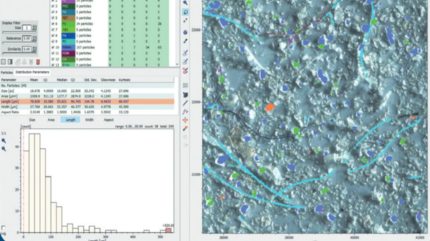
IR Sampling Accessories and Objective Lenses
Validation Plate
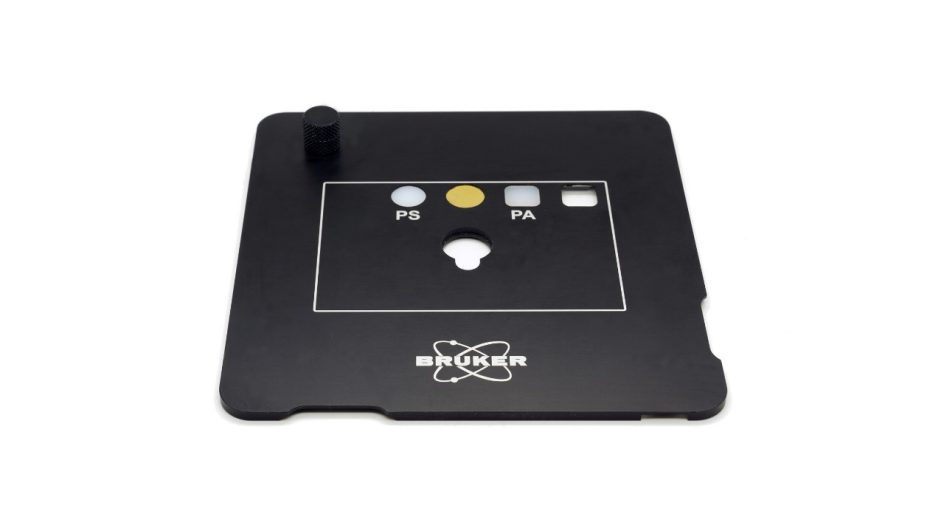
The validation plate is Bruker’s standard accessory for the HYPERION II IR microscope. It comes with reference positions and standard for the automated calibration of the device and allows placement of standard KBr windows.
MicroVice Sample Holder
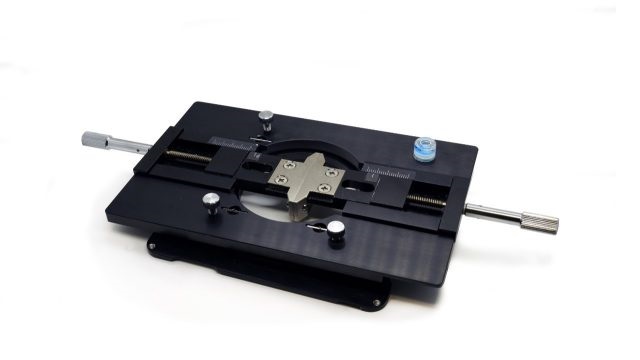
ATR Macro Imaging Accessory
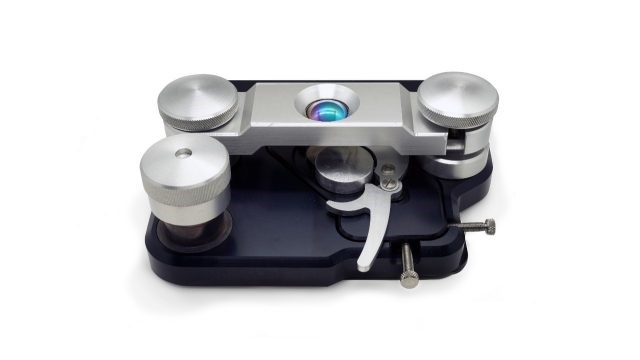
Filter Holder
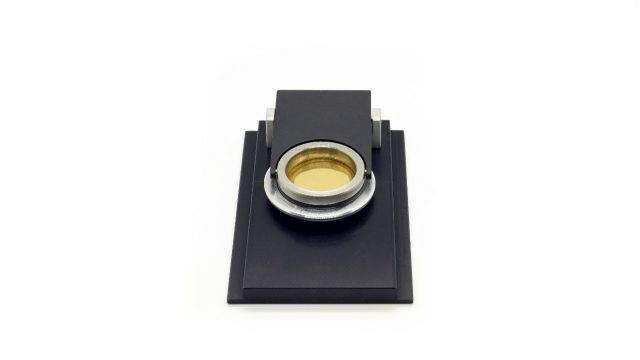
A filter holder with positioning clip that allows precise placement of filters. This accessory facilitates analysis of microplastics or other micro particle samples.
Heating and Cooling Stage
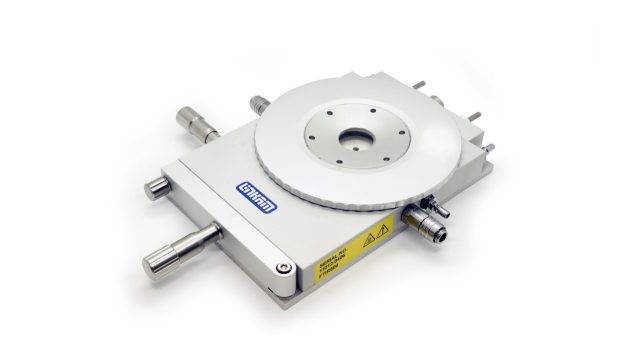
3.5x Imaging Objective Lens
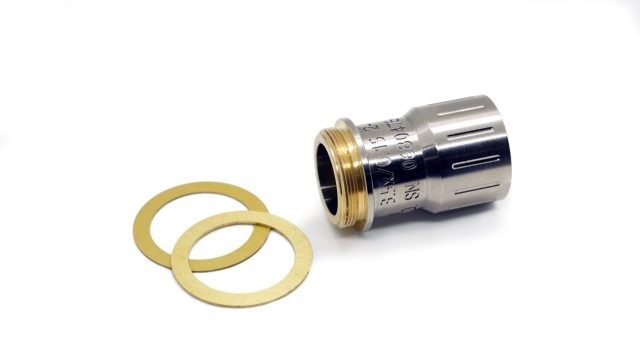
Standard Transmission Objective Lenses
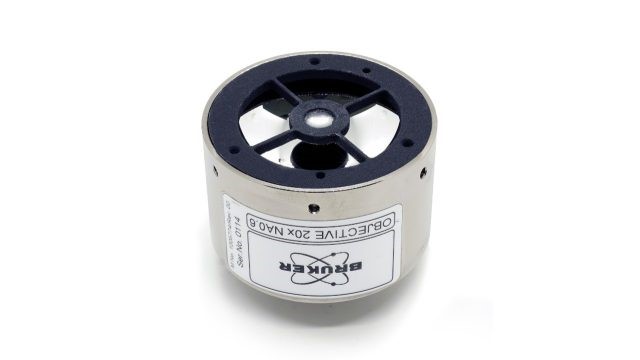
We offer 15x and 36x transmission/reflectance IR objective lenses that were optimized for high infrared light throughput.
ATR Objective
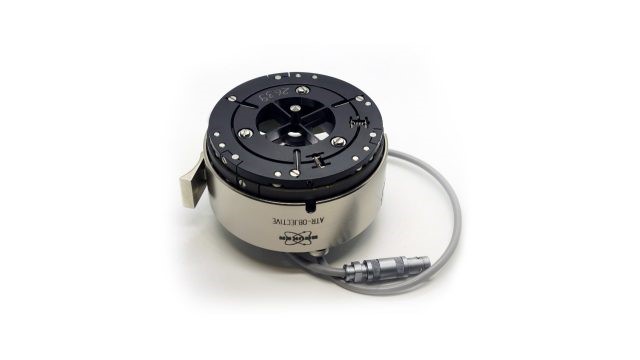
The HYPERION II ATR objective allows crystal clear sample view without sacrificing infrared through-put. The anvil shaped ATR crystal with with a 100 micron contact area allows you to target only the area of interest with full performance.
Grazing Angle Objective
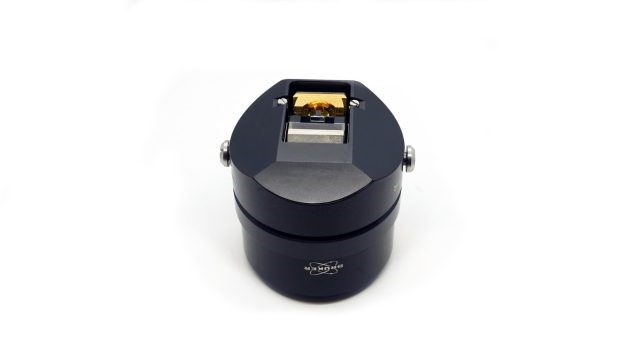
Diamond Compression Cell
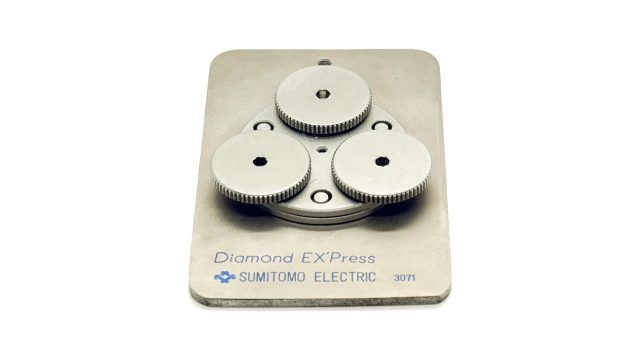
A diamond compression cell which allows preparing samples like fibers, paint chips, rubbers, powders for IR-microscopic analysis. Maximum pressure: 1GPa; 10 N per mm2.
OPUS Release 8.7 | HYPERION II | Q3 2021
New Feature: High Performance Chemical Image Generation by New Adaptive K-means Clustering Function
This new function is the logical next development step for our well known Cluster analysis function.The Adaptive K-means Clustering Function is based on a new algorithm, which enables a non-supervised and autonomous determination of spectral variance within your imaging or mapping results.
- Forecasting or time consuming searching of the included amount of chemical classes is no longer been necessary as the algorithm can predict all included chemical classes by itself.
- This major function is important for all kind of chemical imaging and distribution analysis of unknown samples or small structures within larger datasets.
- Make analysis and evaluation is as easy as possible and safes your valuable time and nerves.
New Feature: “Cluster ID” Function for Identification of Classes in 3D Spectral Data
Our new Cluster ID function enables the identification of clusters within imaging and mapping data using the OPUS functions: spectrum search in libraries, quick compare, or identity test.
- Easy determination of the chemical identity of classified sample components for particles, layers in laminates, components of pharmaceutical tablets and other inhomogeneous materials.
- Reliable and comprehensive statistics reports about quantity, size and of course identity of all analyzed structures is provided and leads particle and technical cleanliness analysis to a new, autonomous level.
Updated Feature: “Find Particles” function now contains a novel particle detection method
The proven “Find Particle” software can now be applied to both: the visual and the IR image. With this updated feature, you are able to do particle detection based on chemical images that were measured by the LUMOS II.
- While particle recognition for low contrast structures and off-white/transparent particles/fibers on off-white filter membranes can be tedious, a postrun particle determination based on the chemical IR image allows you to determine quantity and size of particles from your imaging or mapping results.
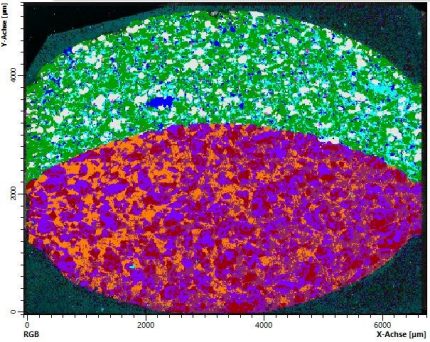
Fully automatically created chemical images by the new adaptive k-means clustering function.
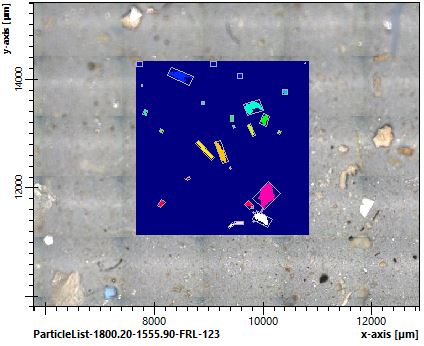
Automatically recognized particles on an aluminum oxide filter. Particles are immediately classified by size and identity with the new “Cluster ID”.
